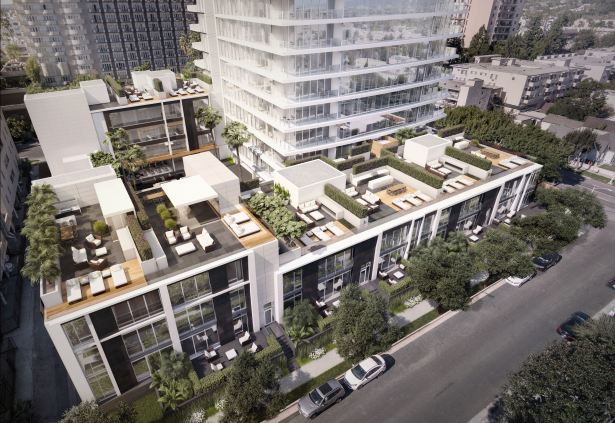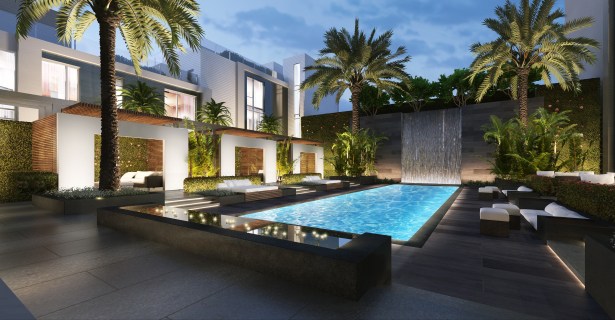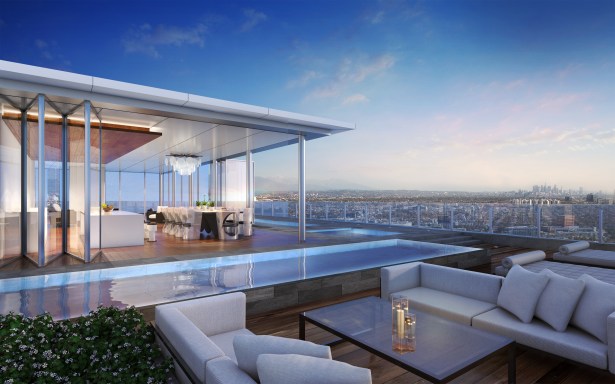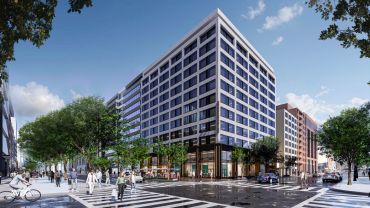Jonathan Genton: Developer of LA’s Most Expensive Condo

When it comes to luxury housing, New York is a vertical town, while Los Angeles has been horizontal.
The Zeckendorfs and Barnetts of the east proved that New Yorkers were willing to shell out tens of millions of dollars on a single unit and share an elevator with their neighbors if the finishes, the architect and location were right—but multimillion dollar housing on the West Coast was always a freestanding affair.
And, with the Four Seasons Private Residences, a 12-story, 59-unit condominium project in Beverly Hills slated to be finished in 2019, which promises a $50 million penthouse (if it sells at that price, it will be the most expensive in town), and remaining units starting at around $3 million, developer Jonathan Genton, the founding partner and CEO of Genton Property Group, is hoping LA homebuyers will do the same.
Commercial Observer recently sat down with Genton, a native Kentuckian whose ancestors were tobacco farmers, at the Four Seasons hotel in Beverly Hills to take a tour of the adjacent residences, find out how Genton switched from architecture to development and why about 70 percent of his buyers at the Four Seasons come from overseas.
Commercial Observer: What got you into real estate?
Jonathan Genton: Legos. Hot Wheels. Lincoln Logs. Things like that. Sort of tripped into it, a bit. I pursued it from an architectural and urban planning perspective—not really knowing what [development] meant as a college kid or a high school kid. But I realized that unless you were a very famous architect you don’t necessarily design the building. You provide a service, but if you really wanted to draw something and you had a vision and you wanted to create it, you probably need it to be the developer. So I changed paths and studied econ at [University of California, Los Angeles] versus architecture.
When you were studying architecture, who was your favorite?
Oh, the basics—the Frank Lloyd Wrights. I would draw buildings as a kid. I was interested in places and [questions], like why does a church feel like a church? Why does where we’re sitting feel different from sitting at In-N-Out Burger?
What was your first project?
Gosh, it was—I think—a couple of office buildings in L.A. I was kind of an assistant project manager for an L.A. developer named David Murdock [of Murdock Development Company]. He had a few office buildings under construction, and I came in as an analyst and I ended up being assistant project manager on a couple office buildings in [the] Brentwood [section of L.A.]. I built houses as a contractor, as an apprentice kind of thing, but that was a first kind of building [I worked on] where you got to see the complexity of things like entitlements, general contractors, tenants, financing.

Take us through how you ended up forming Genton, and what led to the Four Seasons?
What led me to Genton was trying to implement my vision more directly as opposed to working with somebody. I’ve worked with some great people, I’ve worked with some not so great people. But instead of running shop on behalf of somebody, [I wanted] to understand, could I actually do it myself? At the time I had formed several projects and while I understood the development of sales [and] the marketing, the leasing pieces of it was less familiar with the financing side, so I started doing much more of that and I became a bankable guy if you will. So I started that in 2007 with a group of some properties that are what we call creative office. At that time in ‘07 [creative office] wasn’t as defined an industry as it is today, it had very few institutional players in it; it was not a followed asset class like it is in New York for instance. It was rehabbing things as opposed to ground-up. So it was safer, perceived to be a safer bet from an equity perspective.
By the time we started the Four Seasons, we had a nice mix of creative office, and residential. Four Seasons had a desire to expand their brand.
You can expand a hotel brand three ways: you can build or acquire hotels; you can build or acquire mixed-use projects such as hotel and condos; or, you can do what’s called a stand-alone complex. We started with the Four Seasons to do the first stand-alone [condo] project. Obviously, you’re not going to build another hotel and cannibalize the first hotel. So you can do it in markets where there’s an existing hotel, or in markets where there’s not a perceived need for a new hotel. So we acquired the site—which were about 28 or 32 different purchases—took it through entitlement, with the idea that we would expand the brand into a market that it was all already really well known for, but expand it into an asset class that didn’t have exposure and was residential. I had managed 30 or 40 hotels so I knew the whole business; I understood brands but I didn’t understand how to translate that brand it an asset like this. It’s always an enormous learning opportunity. It’s humbling, because these men are smart.

So even back in 2007 you knew this was good?
In 2007 we had the idea to do it. I think we got it acquired through 2009, and the entitlements in L.A. are difficult to obtain. And we had significant litigation, and then we hit the global economic crisis, so we put it on ice for a while. But really during that we got the entitlements done. It had a very difficult branding process and then how do you sell this stuff? Because now you’re selling it to a global market.
How did you solve that?
In terms of its positioning and things like that, we spent a year-and-a-half pre-selling the product. Unlike New York, L.A. is not an off-the-plan town. People in L.A. are not accustomed to buying off plan. In New York they’re going to get 30th floor, unit A. In L.A. that’s not the custom.
Every stage has presented itself with really interesting problems. But having said that, it’s a pretty interesting project because it will change Los Angeles. It definitely has changed Los Angeles, both in terms of price, quality and positioning of the property. L.A. really became a more globally recognized market since the time we started that project. If I would tell you I made a global gateway building in 2009 you would laugh me out of this room, ‘cause I would tell you my buyers come from Hong Kong, Beijing or France. Back then it would be, like, ‘That’s crazy.’ But they did.

And that’s basically been the composition of the buyers?
Yeah. I launched in Jakarta [the capital of Indonesia].
You launched in Jakarta?
So from St. Joe, Ky., to Jakarta. Right?
What was that like?
It was wild.
When was that?
Well, we launched in late 2015, so the L.A. market did not become as robust as it is today, but it had some legs to it. It felt like the confidence levels were coming back. But I still had this enormous barrier to entry in that I hadn’t started construction; there was no building structure. Who buys that? Well, you buy it if you’re in Jakarta; you buy it if you’re in Singapore; you buy it in markets that are accustomed to buying off plan.
Did you pay a lot of attention to how Gary Barnett, and Arthur and Will Zeckendorf sold their properties?
Yeah—the [ideal] is somewhere between Miami and New York. I say Miami because of the product. L.A. should have Miami quality product. There’s great product in Miami. The market is not an L.A. market, but the buildings are pretty cool. And New York has a way of selling that you can’t experience in a Miami or L.A. at the time. So you start looking at all those New York stalwart sellers; they sell off brand.
Right.
I go to New York, and I meet with those [kinds of] guys. And I understand—how do you do a launch market, [even though] we don’t do that in L.A. Now every real estate office has a new development crew and a launch market crew. And I think you gain that through living in Jakarta and Singapore, and Hong Kong and Istanbul. Those are my buyers. And it’s also people from Beverly Hills and Malibu.
So there’s a Beverly Hills buyer for these apartments?
There is, but I think L.A. is primarily not a condo market. For a lot of reasons towered condo units—other than the Wilshire corridor—don’t exist. When you fly into L.A. from any other part in the world, you’re like, these stupid people don’t they know how to build, right? Because we under-produce 45,000 housing units a year. There’s a housing crisis. You can build [high-rises] in Downtown L.A.; you can build them in Hollywood; and you can kind of build them in Century City—maybe. And that’s about it. You go to Miami, you have high-rises everywhere—whereas in L.A. it’s really not the case. If you go from the fourth floor of any building in L.A., you have pretty much unlimited views! I don’t think it’s a tower; to me a tower is 40 stories or 60 stories. And that’s what we can look to do Downtown. But in L.A. would the market love a 40-story building? Absolutely. Would you get it done? Never, ever. [Because of the entitlement process.] I don’t care who you are. You just don’t get it done.
Are there gonna be all the amenities of a Four Seasons?
Yeah—Four Seasons is an intuitive brand, so that’s kind of how they reference themselves. As a hotel guest, or as a resident, they really cater to you. When I go out and explain to people, I try to be a little romantic about it. I think about Ernest Hemingway and Coco Chanel—these are like romantic people, who lived in these private hotels. And that’s really what you get—a private hotel experience. The buyers want the security and the exclusivity of a private hotel with all the services you would otherwise get in a five-star hotel. And they also want higher-quality finishes. I can’t build a really super nice floor and lobby if it’s gonna get used by 6,000 people a day. In theory we have 59 units, but at this point 70 percent of our buyers are international or have homes in other countries. So, it gives you a low impact on our building.
The building is pure glass. I can put in a Gaggenau; I can put a golf range in there; I can put a Sub-Zero in there. All that’s within $500 a foot. But, more than that, I can give you a see-through building. I can give you the perfect building. I can give you walls that disappear. I can give you no columns in a big space. I can give you a building that’s very special. I can give you private elevator access that no one will be in your elevator. I can give you a private garage where you step in and out of your car and no one sees you, you can get in your elevator and end up on your rooftop. Those aren’t finishes—those are horribly more expensive than a tile or a stone!


